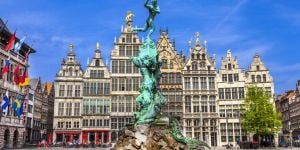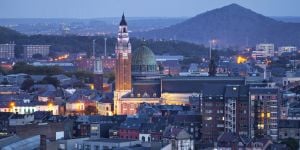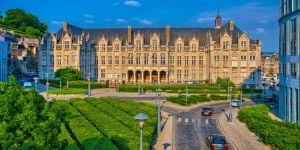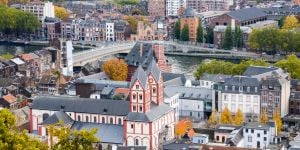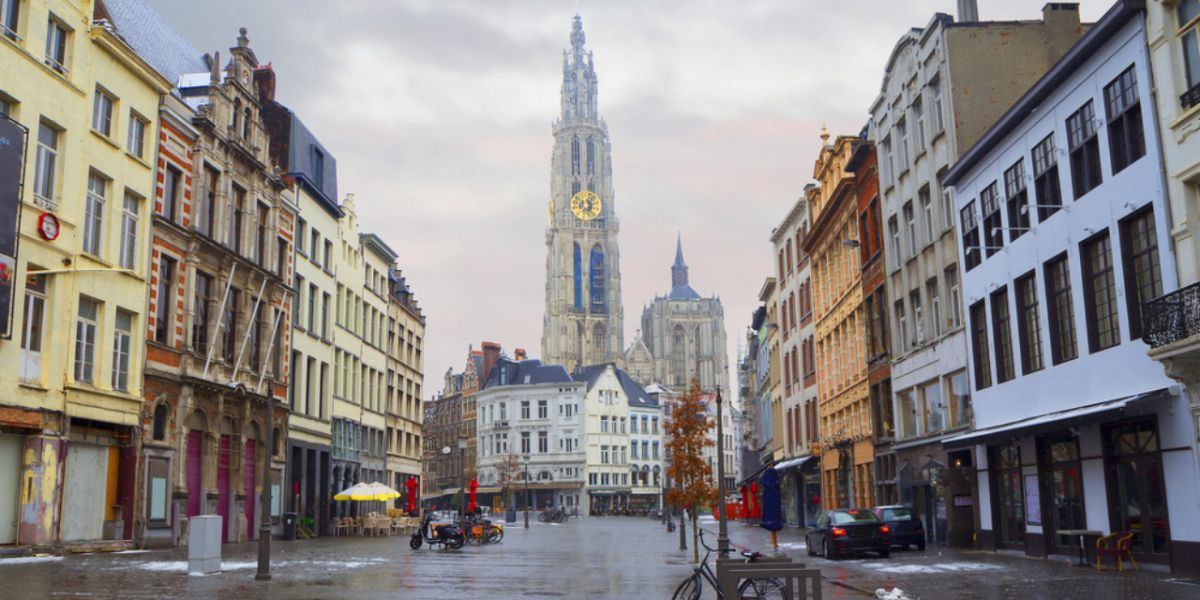
A cosmopolitan and vibrant city, Antwerp attracts residents from all over the world. Whether you are arriving to study, work, or simply start a new life, this city with its rich heritage is sure to charm you. Here are our tips to help you find the ideal accommodation in the diamond capital.
Antwerp: The Belgian city everyone admires
If you thought Belgium revolved around Brussels, well, you were mistaken. In fact, Antwerp is also one of the country's pillars. A Dutch-speaking city in Flanders, Antwerp has nothing to envy from the capitals of the Old Continent. The city boasts a port industry and a petrochemical industry. It is especially a diamond center and a cultural capital.
Antwerp and its districts
Antwerp is divided into nine distinct districts, which were once municipalities (deelgemeenten in Dutch): Antwerp, Berchem, Berendrecht-Zandvliet-Lillo, Borgerhout, Deurne, Ekeren, Hoboken, Merksem, and Wilrijk.
Antwerp
The Antwerp district is the result of the 1958 merger of the old city of Antwerp and the villages of Lillo, Zandvliet, and Berendrecht. This Dutch-speaking district consists of 22 neighborhoods, sharing various tourist attractions. Two of them are the Diamond Museum and the famous Antwerp Zoo.
Berchem
Berchem is a small district of 6.1 km². Nevertheless, it offers tourist attractions such as the Basiliek van het Heilig Hart and the Flemish Tram and Bus Museum at Groenenhoek. More than 40,000 people live there.
If you love Art Nouveau or late 19th-century townhouses, you'll feel at home in the Zurenborg neighborhood. Many houses were built there between 1894 and 1906 and have been preserved after some buildings in the area were granted historic monument status.
For shopping, head to the main street Driekoningenstraat - Statiestraat. It has been recently renovated, making walking much easier and safer.
Berchem is home to Antwerp's second-largest train station: Antwerp-Berchem station. There are also numerous tram and bus lines serving the entire city.
Berendrecht-Zandvliet-Lillo
This district results from the merger of three villages, all located along the port's docks. It houses the largest lock in the world, measuring 500 meters long and 68 meters wide. The lock connects the Scheldt and the river's eastern docks.
Borgerhout
This is the smallest district in Antwerp, with an area of 3.93 km². It is actually divided into two parts, thanks to a highway and historic walls. The area inside these walls is called "intra muros."
The largest shopping street in Borgerhout's intra muros is Turnhoutsebaan. It hosts many trendy bars targeting a younger audience. You can also buy ready-to-wear clothes and food on this street.
Deurne
Deurne is the second-largest district in Antwerp. It is relatively populated with over 80,000 residents in an area of 13.06 km².
If you are environmentally conscious, you will feel at home here. The district is well-known for its Rivierenhof park, the largest park in all of Antwerp. It spans 130 hectares and offers plenty of greenery, as well as an open-air theater.
Deurne also has its own airport: Antwerp Airport. It is actually one of the oldest in the world; it was built in 1923. You should also visit its Stampe & Vertongen Museum.
Ekeren
Before 1983, Antwerp had several municipalities. They all merged in 1983. Then, unexpectedly, in 2000, the Antwerp city council decided to create districts. From there, the first district council of Ekeren was born.
This is another district for nature lovers since it has a one-square-kilometer area called Oude Landen. Until 1972, it was a military zone. And because it was hardly used anymore, it was converted into a nature spot. Today, it is a natural sanctuary with 8 distinct miniature ecosystems, which is fascinating for those interested in ecology and nature.
Hoboken
The Hoboken district covers 10.67 km² and has about 35,000 inhabitants. Its name comes from the medieval Dutch words Hooghe Buechen or Hoge Beuken. This translates to "high/beech trees."
Hoboken is divided into two parts by railway line 52. To the west of the railway are the main neighborhoods: Moretusburg, Hertogvelden, and Polderstad. To the east of the rail are the main districts of Hoboken-center: Hertog van Brabantwijk, Vogeltjeswijk, and Zwaantjes.
Beer enthusiasts will find Hoboken a wonderful place to live. This district hosts an annual race of 5,000 beer servers that supposedly began in 1777.
Merksem
The Merksem district has about 45,000 residents. The most famous part of Merksem is Bredabaan (which means "Breda Road" in Dutch). This road extends north, crosses the Netherlands border, and ends in the city of Breda, hence its name.
Football is an integral part of Merksem's culture. This district includes both the Lotto Arena and the Sportpaleis. So, it is not surprising that many sporting events are organized in Merksem, as well as festivals, music events, and "live" concerts.
Wilrijk
The Wilrijk district has a fun nickname: Goat Village. Every five years, they hold the traditional Geitestoet, a festive parade of goats and folk costumes.
They also have an annual fair (Jaarmarkt in Dutch), a fair where farmers parade their livestock, and everyone is invited to participate in fun activities.
The areas surrounding Antwerp
Besides the main districts, the city has several very pleasant neighborhoods to live in, each with its own style and ambiance. Here are some additional areas to consider depending on your preferences and lifestyle.
The historic city Center
One of the most attractive places to live in Antwerp is the historic city center. Not only is it the most densely populated (which means you are more likely to meet other expats), but it will surely give you a firsthand insight into Antwerp's history.
For example, you can discover the old cathedral and the market square (called Grote Markt in Dutch). Other points of interest include the town hall, the medieval fortress Het Steen, and many museums.
As it is a central district, properties in the historic city center will cost a bit more and be a bit smaller.
Het Zuid
Located south of the city, Het Zuid has become over the years a trendy and artistic district, often compared to a small Belgian "SoHo". It has a high concentration of art galleries, modern museums like the M HKA or the FOMU, and even a Sunday art market.
Het Zuid is ideal for young professionals, as the nightlife there is amazing. But it's also a great neighborhood for families since there is also an international school.
Het Eilandje
Het Eilandje means The Little Island in Dutch. Once a neglected port area, Het Eilandje has completely transformed into a trendy and modern district north of the city center. Its old warehouses have been converted into designer lofts, offices, and restaurants.
The district now houses iconic places like the MAS (Museum aan de Stroom) and the Port House designed by Zaha Hadid.
Considering that this district is very popular, expect the rent to be higher than in many other areas.
How to search for accommodation in Antwerp
You can search for accommodation in Antwerp on dedicated websites, such as Immoweb and Zimmo, which are popular platforms where you can regularly check updated listings. You can also explore Facebook groups dedicated to housing in Antwerp or expats in Belgium, as they often abound with offers posted directly by owners or tenants.
However, it is highly recommended to contact professionals such as real estate agents or specialized agencies, either face-to-face or by phone. They can help you better understand the local market and avoid scams.
If you are already in Antwerp and have your own network of friends and family, don't hesitate to take advantage of word of mouth. Finally, some accommodations are displayed directly in agency windows or via "For Rent" signs (Te huur), which you can spot while walking around the neighborhoods of your choice.
Types of accommodation in Antwerp
When you first arrive in Antwerp, you will probably not have a permanent place to stay. In this case, it would be wise to know in advance the choices available to you in terms of temporary accommodation.
Temporary accommodation
The most popular options are staying in a hotel, a vacation home, a bed and breakfast, or an Airbnb. Although these are more expensive, you can book as many nights as you want, giving you a bit more flexibility while you search for a more permanent rental apartment.
For smaller budgets, youth hostels like Antwerp Central Youth Hostel or Pulcinella are practical options. Some offer private rooms, but comfort remains basic. If you have a lot of luggage or need privacy, consider an economy hotel or a B&B.
There are also studios available for short and long-term stays. They are fully furnished. You don't have to worry about buying things that you will later have to move to your eventual place of residence. Often located near the center or public transport, these studios allow you to discover the city while facilitating your tasks (visits, administration, shopping). They are regularly maintained, saving you chores during this transition phase.
Camping is not common in Antwerp, especially in urban areas. There are a few sites on the outskirts, but they are more suited to passing tourists than new arrivals. It is better to opt for a more practical and accessible solution in the city.
Long-term accommodation
When looking for a long-term rental property in Antwerp, you generally have different choices: rooms, studios, and apartments.
Renting a room is the most economical option, perfect if you are a student or young professional. Rooms for rent usually range from 12 to 18 m². They are often in shared apartments, with shared bathroom and kitchen, which allows for splitting the costs (water, gas, electricity, internet).
If you value your privacy, want more space, and are willing to pay a bit more, consider renting a studio of about 40 square meters. These are open living spaces that can accommodate one person or a couple. This can be ideal if you move in alone or with your partner, as studios can quickly become too small.
At the top of the list are apartments. One-bedroom apartments generally measure 65 m². It is obviously the most expensive option, but if you can afford it, offer yourself the best quality of life.
Furnished or unfurnished accommodation
If you don't want to bother finding furniture and appliances, you should rent a furnished property. It will be more expensive and you will have to pay for any damage caused to the items during your lease.
Opting for an unfurnished property can be cheaper, but you will have to acquire the necessary furniture and appliances for a good quality of life yourself. The good news is that if you move to another apartment, you can take everything with you.
Also know that there is a third option: the "unfurnished shell" or if you prefer: "bare walls".
Very common in Antwerp, this type of accommodation contains absolutely nothing: no kitchen, no lighting, no curtains, sometimes not even a finished floor (just a concrete screed)!
Student accommodation
If you are coming to study in Antwerp, particularly at the University of Antwerp, KDG or Artesis Plantijn Hogeschool, know that these institutions offer housing support, especially for international students. Since places are limited, it is strongly advised to apply as early as possible.
Exchange program students (like Erasmus) often receive only one housing offer through the university. It is better to accept it quickly if you want to avoid the complications associated with finding a kot on your own.
Good to know:
The University of Antwerp does not have on-campus dormitories, but works with private partners (like Brik or Kotweb) who offer quality student rooms throughout the city.
If you prefer an independent solution, you can also rent a private kot or a shared room. This can be much more economical than a studio, especially if you share the costs with other students. Some residences already include electricity, water, heating, and Internet in the rent.
Rent prices in Antwerp
In 2025, the average rent price in Antwerp continues to rise, particularly in the most sought-after neighborhoods like Het Zuid, Het Eilandje, or the historic center. The average monthly rent is now estimated at around €780, or €9.50/m², according to the latest real estate market data.
For student housing, a furnished room in a shared apartment generally costs between €400 and €500 per month, depending on location and included services. Studios, often located near public transport or the city center, range between €600 and €750 per month.
Note that furnished accommodations are generally more expensive than unfurnished ones. If you want to check if the requested amount is reasonable, you can use the online simulator Huurschatter offered by the Flemish region. Charges (water, heating, electricity, internet) are not always included and can represent an additional €150 to €250 per month.
Rental conditions in Antwerp
Before signing a rental contract in Antwerp, it is important to understand the conditions set by Belgian law. Here are the main elements to know.
Documents to provide
Owners or agencies will generally ask for:
- A copy of your ID card or passport;
- A proof of income (pay slip, employment contract, or guarantor);
- Sometimes, a proof of registration in the population register (or proof of temporary residence).
The lease
The standard duration of a short-term lease in Belgium is 9 years, but shorter contracts are possible:
- Short-term lease: 3 years or less. It can be renewed once.
- Student lease: specifically for study-related housing, often one year.
Contracts must be written and registered (legally mandatory, at the owner's expense).
This registration deposit is free for the tenant and protects their rights.
The security deposit
A security deposit equivalent to 2 or 3 months' rent is often required. This amount must be placed in a blocked account in the tenant's name. It cannot be used by the owner before the end of the lease, except in case of damages.
Inventory
A detailed inventory (entry and exit) is mandatory. It must be jointly drafted and signed by both parties. It is highly recommended to take photos, especially if the accommodation is furnished.
Notice of departure
Depending on the type of lease, the notice period varies (generally 3 months). If you leave the accommodation before the end of a long-term lease, compensation may apply:
- 3 months' rent in the first year;
- 2 months in the second year;
- 1 month in the third year.
Tenant insurance
Fire insurance (tenant liability) is mandatory. It covers damage to the accommodation, and sometimes to neighbors. You can purchase it from any Belgian insurance company.
We do our best to provide accurate and up to date information. However, if you have noticed any inaccuracies in this article, please let us know in the comments section below.

